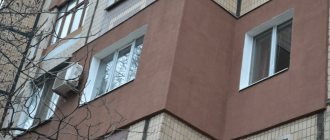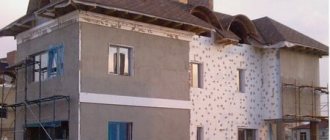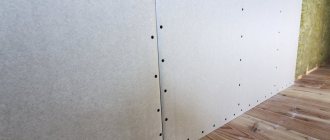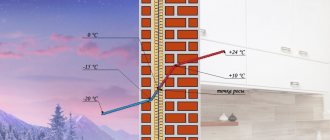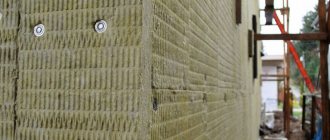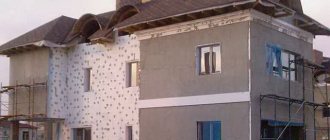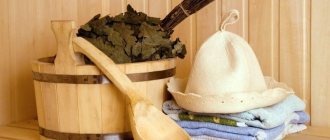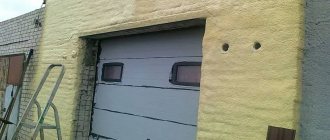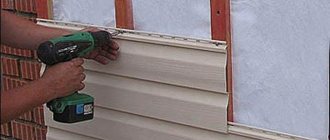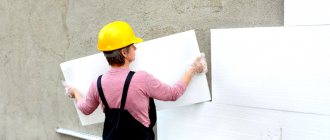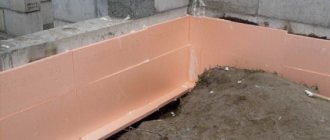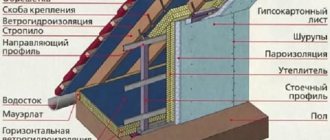Options for insulating walls of panel houses
Modern technologies present two options for insulating the surfaces of the walls of an apartment building: from the inside and from the outside. Both options will solve the problem of low room temperatures and rapid heat loss. In panel houses, cast iron radiators with excellent heating qualities were installed, but due to the thinness of the walls and their direct contact with frosty air, the efficiency of the radiators is significantly reduced.
Both options are suitable for this, but their implementation is radically different, so it is necessary to determine a simpler and more economical one that you can do yourself.
Insulation of the facade of a panel house - what do you need to know?
Panel houses were considered chic during Khrushchev's construction. Insulating the facade of a panel house - a fast and cheap technology made it possible to put into operation a huge amount of square meters, with which residents are still struggling. In roofless buildings with thin walls, it is sometimes too damp and cold. The inner surfaces of the walls are infected with fungus, and mold can even grow in the bathroom.
Figure 1. External insulation of the entire house.
The best option for all residents may be to insulate the facade of a panel house . It is not only Khrushchev houses that suffer from such “diseases”. The technology of panel housing construction is still popular and far from perfect. Therefore, the method should be adopted by all residents of “panelkas”.
External insulation
Insulation of the facade of a panel house is carried out in the following stages:
Preparatory stage
Preparation of the facade surface is necessary - the end walls of the panel house are leveled, the slabs are cleaned of plaque
It is also important to seal voids and cracks; panel joints are sealed. If necessary, it is worth laying a sealant between the joints, while special mastic is used to seal cracks
Unevenness of the wall surface is allowed within two centimeters - such a deviation does not need to be repaired. When all the materials are dry, the wall is impregnated with a universal primer, which is applied using a sprayer or roller.
Installation of insulation
Since in the vast majority of cases foam plastic is used for thermal insulation of panel houses, it is worth considering the technology for installing this insulation. You can fix the foam using the following methods: placing the slabs on glue, fastening them with dowels, or combining these two options, which is the most reliable choice. The direction of pasting is from bottom to top. In this case, pasting begins with the installation of the starting strip.
After this, we begin to apply glue to the surface of the panel house - the technologies used directly depend on the quality of the walls. If they are smooth, then you can apply glue with a comb. If, as often happens, the walls are uneven, then the glue is simply thrown onto the surface
It is important to carefully fill the seams with glue. All this allows you to get rid of voids under the heat insulator
There is no need to apply glue to the foam.
The option when the glue is applied to the foam plastic, and not to the house, is not suitable in this case, since the voids under the insulation will become natural cold bridges, which will reduce the effectiveness of the entire event.
We apply the foam to the glue layer and press it well. After gluing all the plates, you need to leave them alone for several days. During this period, the adhesive solution will dry and shrink, after which the next stage of work can be performed. As for fastening the slabs with dowels, you can choose plastic mushrooms. This is due to the lightness and low strength of polystyrene foam - such fasteners will save the facade from unnecessary heat loss.
As for the dowel caps, they must be covered with an adhesive mixture. All irregularities remaining after the glue has dried can be removed with regular sandpaper.
Preparation for reinforcement
The fragility of polystyrene foam is a serious drawback, so the insulation needs reinforcement - just glue a thin mesh. Such protection should prevent the destruction of the foam due to atmospheric phenomena and other unfavorable factors.
Preparation for reinforcement proceeds as follows: first, the corners are pasted over, after which you can proceed to pasting the walls themselves. To simplify the process, meshes with ready-made corners are used, which minimizes time consumption. If there are no such meshes, then you will have to make corners from a regular mesh. It is enough to cut a long strip 30 centimeters wide and bend it at an angle - this design is pressed against the corner of the house greased with glue. In general, cutting the mesh into fragments greatly simplifies the installation itself, which allows you to sequentially cover the areas coated with glue with fragments. In this case, the mesh should overlap at the junction.
After gluing the mesh, you need to wait for the glue to dry, after which you can use a plastic float to clean off the excess solution and remove any unevenness.
Finishing
Before finishing, a leveling layer is applied to the entire treated façade. After this, it is necessary to apply a primer and a layer of plaster. The final stage is painting the wall, preferably in a color that will not stand out too much against the background of the main color of the multi-story panel building.
No. 4. What's wrong with spot insulation of an apartment building?
As soon as we drive through a number of post-Soviet cities, we will see the same unpleasing picture - the walls of high-rise buildings are completely covered with spots of different colors. These are residents trying to make their apartment more comfortable. Of course, this sight does not cause disgust, irritation, or any other negative reactions in anyone, but the main problem is not even the appearance, but the quality of such insulation, its durability and the safety of the walls of the house.
The boundaries of the insulation of a separate apartment run exactly along the floor slabs. In these places, the dew point sharply shifts from the insulation into the wall , which leads to moisture condensation and the risk of mold, and the fungus can appear both in the insulated apartment (at the junction of the wall with the ceiling and floor) and in neighboring apartments. The difference in temperature of the façade wall in neighboring areas is also not beneficial to the house. As a result, we can talk not only about the problem of high humidity, but also about the gradual destruction of the main wall.
Another problem is the constant wetting of the upper end of the thermal insulation . Although they try in every possible way to protect it from precipitation, the constant exposure to moisture and the accumulation of snow gradually destroys the adhesive fastening of the thermal insulation and allows water to enter. It is difficult to create a continuous contour of thermal insulation, therefore complete tightness of the insulation area is practically impossible. We will not mention the aesthetic problem of spot insulation anymore.
Ideally, it is necessary to negotiate and insulate the facade of the house completely, from the basement to the attic, especially since it will cost less than individual insulation, even if you do not use any programs or benefits.
Insulation materials
The modern construction market offers an alarmingly large selection of thermal insulation materials. The “ordinary” man in the street, not familiar with the specifics of the work, is dizzy from such diversity. Unscrupulous sellers take advantage of this, instilling the idea “the more expensive, the better.” Today we will not consider all the options for insulating the external walls of a house, but we will talk about the most inexpensive, high-quality materials that have been proven over the years.
Styrofoam
Among the most popular insulation materials, foam occupies a special place. This is an inexpensive material that properly performs its intended function. It is perfect for external insulation, as it provides 100% thermal insulation regardless of air humidity and temperature changes.
This material is non-toxic and fireproof, but a reservation should be made here. The foam itself does not burn, but melts and at the same time emits black acrid smoke, which is hazardous to health. But if you follow safety measures, it will last a long time and faithfully. The words about non-toxicity and harmlessness to health are confirmed by the fact that even children's products and food products are packaged in polystyrene foam.
Polyfoam is not susceptible to mold, fungi and insects. It does not deteriorate, does not swell or shrink, maintaining its original shape. The service life of the material ranges from 20 to 50 years, depending on the quality.
External insulation of the walls of a house with foam plastic allows not only to protect the interior from the vagaries of the weather, but also transforms the outside of the house. The material creates a very convenient surface for finishing, ranging from relief plaster to siding or slabs.
Working with polystyrene foam is quick and easy; all you need is basic skills and equipment.
Stages of insulating the external walls of a house with polystyrene foam:
- Prepare the walls by cleaning them from dust and dirt with a construction brush. If there are cracks or chips, seal them with plaster so that the foam sticks well.
- Glue the foam plastic with a special compound onto the pre-primed wall. You need to glue the sheets in a checkerboard pattern, pressing them closely together. To ensure that the material holds well, additionally secure it with plastic dowels.
- Install fiberglass mesh over the slabs. To do this, apply a thick 5 mm layer of glue to the sheets and “drown” the mesh in it.
- All that remains is to plaster the surface, cover it with facade paint or perform any other finishing.
Penoplex
Today you can often hear advertisements for high-quality and reliable penoplex insulation, which is why many people believe that this is the name of the material. In fact, the material is called extruded polystyrene foam, and it is produced under the Penoplex brand.
Extruded polystyrene foam is used for internal and external insulation of houses of any type. Today it is one of the most popular materials, and this is explained by its excellent performance characteristics.
Advantages of penoplex:
- environmental friendliness;
- low thermal conductivity;
- high density;
- retains heat better than foam;
- high strength;
- high density;
- low vapor permeability;
- absolute fire safety (ignition temperature 500C, which is unrealistic at home);
- durability;
- ease of working with the material;
- relatively low cost, which quickly pays for itself.
Unfortunately, ideal building materials do not yet exist, so even with such a large list of advantages, penoplex also has disadvantages. The most obvious is poor adhesion. Since the material is very dense, it does not absorb adhesives well, so it is difficult to glue it to a vertical surface. To do this, additional fixation is performed with dowels, but most builders recommend using penoplex for internal insulation.
External insulation of the walls of a house with penoplex is best done in the basement area, since even additional fixation of the material will not protect it from damage. In other words, it very quickly begins to fall off and spoils the appearance of the building. In the area of the plinths, you can make a ventilation space or use an outer layer of waterproofing to prevent the adhesive layer from getting wet and breaking down.
https://youtube.com/watch?v=KA5pPEDRxwY
Insulation of walls from the inside in a corner apartment
If you have experienced the purchase or sale of apartments, then you have noticed that buyers do not really like corner apartments or rooms. What is this connected with? Although it is much easier to ventilate such an apartment in summer, the view from the windows opens on two or even three sides.
But there is one significant drawback. Very often, with the arrival of frost, residents of corner apartments suffer from insufficient heat. If the temperature outside is around zero, and the heating season has not yet begun, uncomfortable conditions are created inside such an apartment. Dampness appears in the corners, the windows fog up, the floor becomes cold, and the bed becomes damp.
The main reason for this is the presence of three walls that have access to the outside and are therefore most susceptible to low temperatures. In winter, even with central heating, the situation only gets worse.
The walls can freeze completely, especially in the corners, the interior decoration will begin to fall off, and mold and mildew will appear. Staying in such an apartment will not only be uncomfortable, but also unsafe, especially for children. After all, they are most susceptible to diseases caused by high air humidity.
What to do in such a situation? Many people try to install additional heating radiators, but this, most often, does not solve the problem or solves it, but not completely. Dampness moves to the ceiling, forming places where mold accumulates.
What is the right thing to do in such a situation? The best solution is to try to insulate the walls. How can I do that? How to carry out internal insulation? We'll try to figure it out now. What is the best way to insulate the walls of an apartment from the inside? First, let's look at what insulation materials exist.
Types of insulation
The choice of which material is best to insulate the walls from the outside is influenced by:
- location of the panel house in a certain climatic region,
- amount of precipitation, wind strength and speed,
- allocated budget for insulation of a panel house,
- other individual factors.
The estimate and project for the work are usually drawn up by the management company or the HOA. A team of industrial climbers directly carries out the insulation process from the outside.
For panel houses, two types of insulation are mainly used:
Mineral wool
For outdoor work, it is convenient to work with mineral wool slabs, which are produced by various manufacturers. It has good performance in basic characteristics, including thermal conductivity. However, you need to ensure that the mineral wool does not get wet, otherwise it will lose its thermal insulation properties. To do this, a vapor-permeable membrane is laid under the insulation layer, which will protect it from vapors.
When finishing a ventilated facade, condensation from the walls of the house will be removed due to the air gap and the membrane does not need to be used.
Styrofoam
It is distinguished by its lightness and simplicity when laying slabs on the wall. Also has good parameters for heat and sound insulation
For outside work, it is important to use a material that does not support spontaneous combustion. Manufacturers mark it with the G1 marking, however, the results of many tests confirm that the foam is flammable, and this name does not meet the requirements of GOST 30244-94
When purchasing insulation, be sure to ask the seller for product certificates.
The insulation of a panel house from the outside is limited by the thickness of the insulating material. The maximum value of the foam thickness for walls is calculated using special formulas, taking into account the average temperatures in a certain climatic region and the purpose of the building (residential, public, industrial).
Method of insulating external walls in panel houses
Method of insulating external walls with foam plastic “Wet facade”.
Let's look at how to insulate a panel house from the outside using the wet facade method. It's quite simple:
- apply the adhesive to the foam boards and press them against the wall;
- after the glue has hardened, the slabs are secured with dowels;
- the first layer of putty is applied on top of the foam;
- until the first layer has dried, reinforcement mesh and plastic corners are embedded in it;
- the finishing layer of putty is applied;
- a visor is installed along the upper edge of the insulation;
- The finishing putty is primed and painted.
The slabs are laid according to the principle of brickwork, with the seams offset to the side by half the slab. If the working surface is perfectly flat, then the glue can be applied with a notched trowel over the entire surface of the foam sheets. If the surface is uneven, then dot it with flat cakes. How to apply the adhesive foam is indicated on the bottle.
We looked at how to insulate a wall from the outside in a panel house correctly; in practice, you can see the picture when foam panels are attached only to dowels. Such craftsmen should be kicked out - this is a gross mistake, because of which the insulation will be of no use. When there is no glue, there is a single air layer under the insulation layer. It is definitely not possible to completely seal the ends of the insulation; as a result, air will circulate through the air gap, as in a ventilated facade.
Cold street air will take all the heat from the walls, and the insulation layer in this case will simply hang on the wall. Even heating engineers calculate the degree of heat loss of materials up to the ventilation gap, that is, everything that is located behind the ventilated gap does not perform any insulating function. Therefore, there must be glue in any case, at least to separate one slab from another, so that air cannot circulate under the foam layer.
Insulation options
Insulating a panel house from the outside allows you to stop the flow of heat through the concrete. An additional layer of thermal insulation will provide protection from the destructive effects of external factors. On the market today you can find many materials that can be used for insulation inside or outside.
Insulation inside
For a panel house, insulating it from the inside will only make the situation worse. This is due to the movement of the dew point, which will move closer to the inside of the wall. In practice, this means that moisture will accumulate in the walls with even greater force - both the wall and the insulation will get wet, so the service life of the facade will be significantly reduced. To avoid such a situation, and at the same time reducing the usable area of the apartment and destroying the design, you should give preference to insulating a panel house from the outside.
Insulation from outside
The difficulty is that insulating a panel house with a large number of floors is only possible with the help of climbing equipment. It is clear that it is almost impossible to get money to pay specialists and buy building materials from utility services. Moreover, an attempt to insulate a house at the expense of the residents also does not always meet with understanding from all project participants. Therefore, you can take the path of least resistance and insulate a separate apartment.
The main advantages of external insulation:
- There is no need to disturb the interior decoration of the premises;
- The internal usable area of the apartment is preserved;
- The supporting structure of the “socket” is strengthened, that is, the building is strengthened, which has a positive effect on its service life;
- The insulation is an additional sound insulator;
- The temperature inside the room increases with the same heating costs, since the walls are protected from freezing - heat loss through the panel box is reduced.
No. 1. Insulation of an apartment building: outside or inside?
The walls of the house can be insulated from the inside and outside . We all know that external insulation is used much more often, because it is considered more effective. However, in some cases, only internal thermal insulation is applicable, and, by the way, it also has its advantages.
Internal insulation can solve the problem of energy saving, but the process must be approached very carefully. An error in calculations or installation can cause the dew point to shift inside the house, which will cause the façade wall and insulation to become wet. The consequences of this process are dampness and mold in the apartment, a decrease in the durability of the external walls of the house and, naturally, a decrease in the thermal insulation qualities of the insulation. Other disadvantages of internal insulation include :
- reducing the usable area of the room;
- the need to install a powerful ventilation system;
- the difficulty of carrying out work to avoid moisture condensation;
- it will be impossible to live in the room during insulation work;
- even if all work is carried out correctly, it will not be possible to avoid freezing of the wall of the house, because it will not warm up from internal heat;
- faster cooling of walls.
Internal insulation of an apartment in an apartment building has its advantages :
- faster heating of walls;
- the ability to complete all the work independently, since there is no need to involve teams with industrial climbers. On the other hand, in order to competently complete all the work, a high level of qualification will be required;
- internal insulation can be performed together with repair work;
- internal insulation is the only way to make an apartment warmer if it is located in a building that has historical value and residents are prohibited from changing the appearance of the facade.
External insulation of the facade of an apartment building has many more advantages:
- the heat inside is retained longer, the room maintains a relatively stable temperature in both summer and winter;
- the area of the apartment does not decrease;
- You don’t have to leave the apartment during insulation work;
- a layer of insulation and decorative finishing protect the walls of the house, extending their service life.
Among the disadvantages :
- impossibility of carrying out external insulation on your own. True, some residents of the first floors take on such work, but at the same time you need to be well confident in your own qualifications;
- spot external insulation is more harmful than beneficial, which we will discuss below.
External insulation can change the appearance of the facade of a house, and this can be both a plus and a minus. If the entire house is insulated at once, then from a typical gray Soviet high-rise building you can end up with a nice modern house with a stylish facade. This is a significant plus. But if the residents have not reached a consensus on issues of insulation, then insulation is carried out fragmentarily, in patches, and then the appearance of such a house leaves much to be desired.
Installing insulation on brick walls
How to insulate brick walls inside an apartment with your own hands? Corner walls in a brick house can be insulated using the same method as in a panel house. Therefore, we will analyze the work of installing material made from polystyrene.
Insulating a wall in an apartment from the inside:
- clean the walls down to the plaster. If it is missing, then it should be applied. After this, the walls must be leveled, cracks repaired and then treated with a primer;
- you need to prepare the glue according to the manufacturer's recommendations and apply it to the walls that you will insulate. In the beginning, you can use a regular spatula. You need to apply glue to the walls, then take a notched trowel and go around the entire perimeter again. This is done in order to create an uneven surface of the glue. This promotes better adhesion of the insulation;
- how to insulate a wall in a corner apartment from the inside? Next, we take sheets of thermal insulation and begin installing them on the walls. First of all, the very bottom row is laid. We apply the polystyrene sheet tightly and press it through; you do not need to use dowels or other fastening materials. When installing, use a level and carefully join the edges so that no gaps form; if necessary, cut the sheets. The next row is installed so that the junction of the two sheets is in the middle of the bottom sheet. This will give greater durability to the entire structure.
Watch the surface of the insulation so that no unevenness is formed, because this will bring additional difficulties during final finishing.
After you have installed the thermal insulation, you can begin finishing work. If you plan to cover the walls with plasterboard, then no additional work on the insulation is required. If you plan to cover it with a layer of plaster, putty, wallpaper, or paint, then you need to treat it with a primer, then install a mesh of reinforcing fiber. After this, you can begin to apply layers of plaster or putty.
By following these steps, you can insulate a corner room from the inside.
Installation of insulation
Technology of applying glue to foam plastic. Click on photo to enlarge.
There are several methods for installing polystyrene foam, but the most effective is the one that involves gluing and nailing it. This insulation of a panel house is most effective.
The pasting process begins from the bottom of the building, where the starting strip is mounted. To work, you need to have 2 spatulas: a large one (20 cm in size) and a smaller one (8-10 cm in size). A smaller tool is used to apply the adhesive mixture to another spatula. The adhesive mixture is applied to an uneven wall using “blunders”, and to a smooth wall using a comb. Do not forget about carefully filling the seams. There is no need to apply the mixture to the foam sheet itself.
Before insulating a panel house, you should fill all the depressions on the outside with an adhesive mixture, otherwise there will be voids under the foam sheet, which will allow heat to escape from the apartment. Convex areas are coated with a thin layer. Next, apply the sheet to the surface and press it.
To achieve a good result, you can continue insulation only 3 days after the foam glued to the walls in the panel house is securely fixed. Usually craftsmen first cover the outside of the building with insulation, and after 3 days they begin to nail it down.
Nailing foam to the wall is done using fungi, which consist of a plastic sleeve, a circle and a nail driven into the sleeve. The nail can be metal or plastic, but since metal is a cold bridge, you should give preference to plastic products.
Using a puncher, holes are drilled in the foam, for example, around the perimeter of the sheet and in the center. This will allow the apartments of the building to be reliably thermally insulated. The drill diameter should be 10 mm. The depth of the hole should not coincide with the length of the fungus, but on the contrary, exceed it by 2 cm. Otherwise, the fastener will not completely fit into the hole, but will stick out outside, since construction debris will remain in it.
It is possible to ensure reliable insulation of an apartment only if the foam in the panel house fits tightly to the wall and there are no large gaps between the plates. Filling of seams with a size of 5 mm or more is carried out with polyurethane foam. But if their width exceeds 2 cm, then insulation is placed in them, and only then filled with foam. When it dries, the excess is cut off. At this stage, you can correct the protruding seams by rubbing them.
Continuing the insulation with foam plastic, it is necessary to move on to puttying the fungal caps and seams in panel houses with an adhesive mixture. All minor defects after the putty has dried are removed using a plastic grater with emery.
Methodology for insulating walls from the inside
Foam adhesive is best suited for gluing foam boards.
Insulation insulation in the apartment on concrete walls is attached from the inside under false walls made of plasterboard. If you took the path of least resistance and chose stone wool or, in extreme cases, foam plastic as thermal insulation, then no difficulties should arise in your work. How to insulate a corner apartment in a panel house:
- installation of structures made of metal profiles;
- laying thermal insulation under the guides with glue - you need to create a monolithic screen, so there should be no gaps at the joints;
- covering a metal structure with plasterboard.
After it has been puttied, you can glue any finish onto the drywall: tiles, wallpaper, decorative stones, papier-mâché, or simply paint it. There are situations when it blows strongly from the corners. In this case, the question arises: how to insulate corners in a panel house? Alternatively, you can simply blow them out with foam from the inside or cover the joints of the plates with sealant. This should help, but if capital measures are needed, then it is necessary to insulate the interpanel seams from the outside. There is a technique called “Warm seam”. It involves cleaning the seam from all contents, filling it with special polyurethane foam, laying Vilaterm and sealing the seam with mastic.
Insulation of a panel house - briefly about the main thing
Faced with the need to reduce the heat loss of an apartment in a panel house, you need to consider the issue in the following sequence:
- sealing seams between panels;
- insulation of external walls with foam plastic using the wet facade method.
Sealing the joints may be enough to make it warmer. This will cost much less than insulating the end walls of panel houses. If you are not satisfied with the result, then you will have to insulate with polystyrene foam; naturally, the effect of insulating the walls in tandem with sealing the seams will be greater. The polystyrene foam is attached to the wall using universal dry glue, which is diluted with water, or foam glue. Additionally, fixation is carried out with dowels. Foam is better than regular glue, it is more reliable and easier to work with. At the same time, it will be more profitable in terms of price to buy adhesive foam if it is used as recommended by the manufacturer.
Materials for insulating the walls of panel houses outside
Today's market for thermal insulation materials is huge, but there are products that are deservedly considered classics of thermal insulation of a panel house outside
.
Among these materials are:
- mineral wool;
- sandwich panels;
- Styrofoam.
Let's look at each of the options separately to understand what advantages this or that type of insulation has.
Mineral wool
Mineral or stone wool
usually called insulation based on extruded stone chips.
The point of using stone is that it creates a foam slab with stable walls. The internal space of such a stove
is 90% filled with air. And today air is the material with the lowest thermal conductivity. Therefore, all insulation materials include air.
There are three types of mineral wool:
- Basalt mineral wool with a synthetic binder. This is the most popular option. If you hear someone talking about mineral wool, then most likely they mean this type of insulation. Mats made from this material are loved by all heating engineers for their ease of installation, low cost and good thermal insulation properties. However, basalt wool is used extremely rarely for insulating façade houses, since its installation requires a frame that must be thermally insulated separately to prevent cold bridges from appearing.
- Glass wool. It was used everywhere for insulation in the last century. Now it is completely unsuitable as insulation: it constantly crumbles, falls off quickly and is extremely dangerous to install. When installing basalt mineral wool slabs
, it is enough to use a respirator. To install glass wool blocks, you will have to protect your entire body. In addition, the thermal insulation characteristics of the material are very mediocre. - Mineral wool based on cellulose. The name speaks for itself. This is a fire hazardous insulation made from foamed paper residues. The main advantage that manufacturers are trying to cling to is environmental friendliness. But the insulation does its job poorly, and therefore there is no particular point in using it.
Sandwich panels
Sandwich panels are used primarily due to the possibility of quick installation. The panel itself is insulation sandwiched between two layers of structural material. The following acts as insulation:
- Foamed polyurethane. High quality but expensive material. It is not profitable to use it to insulate the facade of an apartment panel building. But a sandwich panel with such insulation is perfect for a private home.
- Mineral wool. This insulation has already been mentioned earlier; all its properties are transferred here completely. The use of sandwich panels protects the mineral wool board from precipitation, making installation easier.
- Styrofoam. These are the most popular sandwich panels. The insulation used makes them lightweight and quite effective.
Styrofoam
Styrofoam
is the most popular material in Russia for insulating building facades. The undoubted advantage of this insulation is that it is absolutely not susceptible to moisture, when the basalt mineral wool slab turns into rags over time. As a rule, the service life of such insulation does not exceed 10 years. Foam manufacturers guarantee from 30 to 50 years of service.
The foam is attached to the facade using dowels
or with special glue. And most often, both methods are combined to create a reliable fastening.
What you will need to work on insulating a room in an apartment building
Insulation work will require proper skill and attention, but it can be done easily if you strictly follow the technology and have the necessary tools at hand. Here is a list of what you may need:
- construction stapler;
- polyurethane foam;
- sealant gun;
- screwdriver;
- hammer drill or powerful drill;
- construction knife;
- ladder or trestles;
- hammer;
- metal screws;
- metal corners;
- liquid level;
- thread;
- serpyanka;
- putty knife;
- liquid nails for exterior use;
- plastic mushrooms for attaching foam;
- vapor barrier film.
The specified list may be wider depending on the installation method, but you can easily get by with what is listed. Having everything you need, you can get to work. Remember that it is better to ventilate the room well, and carry out noisy work only at the permitted time of day in order to avoid conflicts with neighbors.
How to insulate a panel house. Step-by-step instruction
The instructions for insulating a panel house contain the following steps:
- selection of material and its quantity depending on climatic conditions and purposes;
- purchase of materials and construction tools;
- drying walls using a heat gun;
- removing possible finishing from walls to be insulated;
- applying an antiseptic composition to surfaces that will soon be covered;
- applying a primer; (read how to apply primer correctly in the article Primer of walls - surface preparation)
- sealing seams, if necessary, additional insulation;
- installation of insulation (using glue, plasterboard sheets and a metal frame);
- use of metal mesh for additional reinforcement;
- finishing of insulation if necessary.
The start of work should be on the lower part of the wall, because this is where the starting bar is installed. It is most convenient to apply the glue with a spatula.
Materials
According to its technical characteristics, work on installing a heat-saving coating in a panel house from the inside is carried out from the following common materials:
- mineral wool;
- extruded;
- polyurethane foam;
- foil (reflective) thermal insulation;
- insulating paint.
When installing light insulating cladding, walls without lining the top with durable sheets of insulation boards (foam plastic, expanded polystyrene, stone basalt wool) are simply hidden with a layer of plaster:
An important criterion for selection is the non-flammability of the material and environmental safety, since it is installed indoors.
You can compare the indicators that this or that thermal insulation has using the table:
Roll materials
It is one of the popular options for insulation because it has a number of undeniable advantages:
- Easily cut into pieces of the desired size.
- Repeats the shape of the surface (tightness).
- It is sufficiently vapor-permeable so that additional membranes are not used in the design.
- Does not burn, unlike polymers, does not produce toxic smoke when heated.
- Resistant to microorganisms.
Available in the form of rolls, stitched mats and slabs. Of all types of this material, stone basalt wool is preferable.
Foiled polyethylene foam is used to reflect infrared radiation and create a barrier to water vapor. Heat rays practically do not penetrate to surfaces hidden under the finishing sheet covering, so there is little point in installing reflective insulation in the walls.
Can be used as protection of mineral wool from a wet wall, additional sound insulation, vibration damping.
Natural cork is used for high-quality internal insulation of small thickness on panel walls. This is the most environmentally friendly heat insulator. Performance characteristics include high strength, low thermal conductivity, low weight, durability, and elasticity. For more information about which insulation is better, watch this video:
Foam boards
The technology for insulating the walls of a panel house from the inside with smooth, rigid slabs of foamed polymer includes careful preparation of the surface for installation. Unresolved wall deflections will create voids in which condensation will accumulate.
The slabs are laid out staggered on a layer of glue; the use of anchor umbrellas in this case is not recommended (through passages for cold). Each joint is sealed with sealant. Another method of fastening is to lay it between a T-shaped profile fixed to the ceiling and to the floor.
The thickness of the material will depend on the climate zone. The following initial data can be used in the calculation:
Liquid formulations
Applying a layer of polyurethane foam requires special equipment and installation of a frame. The work is carried out by specialists with practical experience. The strength of the hardened foam is low and it is covered with a protective cladding (gypsum plasterboard, plywood). For more details, watch this video:
Liquid types of insulation include the achievement of modern science - special paints. They are expensive and require careful adherence to application technology (thickness and sequence of layers, direction of brush movement). If the instructions are violated, the thermal resistance of such a coating decreases sharply.
The thermal insulation properties of concrete panel houses leave much to be desired, since they are very hot in summer and cold in winter, which leads to increased energy costs for heating. This problem can be solved by thermal insulation of the walls, however, this issue must be approached competently. Therefore, next I will tell you how to properly insulate a panel house.
